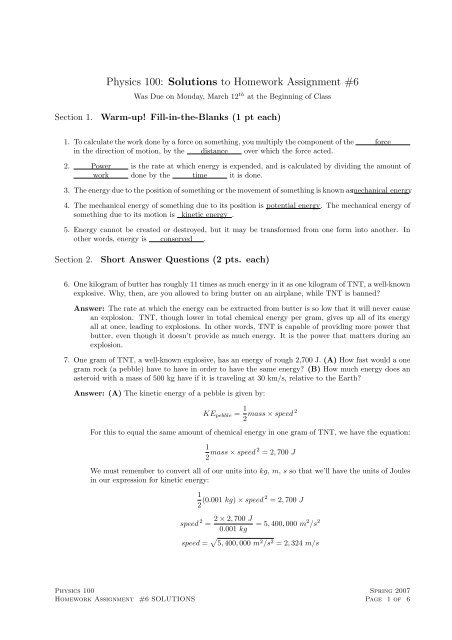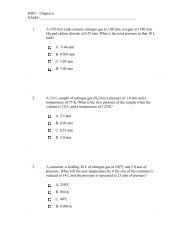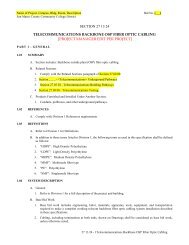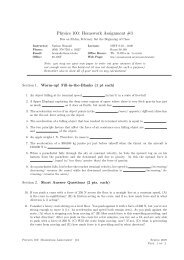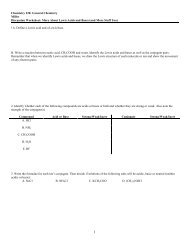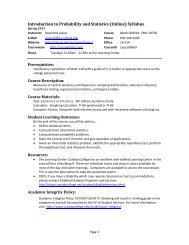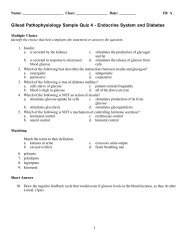Physics 100: Solutions to Homework Assignment #6
Physics 100: Solutions to Homework Assignment #6
Physics 100: Solutions to Homework Assignment #6
You also want an ePaper? Increase the reach of your titles
YUMPU automatically turns print PDFs into web optimized ePapers that Google loves.
<strong>Physics</strong> <strong>100</strong>: <strong>Solutions</strong> <strong>to</strong> <strong>Homework</strong> <strong>Assignment</strong> <strong>#6</strong><br />
Was Due on Monday, March 12 th at the Beginning of Class<br />
Section 1.<br />
Warm-up! Fill-in-the-Blanks (1 pt each)<br />
1. To calculate the work done by a force on something, you multiply the component of the force<br />
in the direction of motion, by the distance over which the force acted.<br />
2. Power is the rate at which energy is expended, and is calculated by dividing the amount of<br />
work done by the time it is done.<br />
3. The energy due <strong>to</strong> the position of something or the movement of something is known asmechanical energy.<br />
4. The mechanical energy of something due <strong>to</strong> its position is potential energy. The mechanical energy of<br />
something due <strong>to</strong> its motion is kinetic energy .<br />
5. Energy cannot be created or destroyed, but it may be transformed from one form in<strong>to</strong> another. In<br />
other words, energy is conserved .<br />
Section 2.<br />
Short Answer Questions (2 pts. each)<br />
6. One kilogram of butter has roughly 11 times as much energy in it as one kilogram of TNT, a well-known<br />
explosive. Why, then, are you allowed <strong>to</strong> bring butter on an airplane, while TNT is banned?<br />
Answer: The rate at which the energy can be extracted from butter is so low that it will never cause<br />
an explosion. TNT, though lower in <strong>to</strong>tal chemical energy per gram, gives up all of its energy<br />
all at once, leading <strong>to</strong> explosions. In other words, TNT is capable of providing more power that<br />
butter, even though it doesn’t provide as much energy. It is the power that matters during an<br />
explosion.<br />
7. One gram of TNT, a well-known explosive, has an energy of rough 2,700 J. (A) How fast would a one<br />
gram rock (a pebble) have <strong>to</strong> have in order <strong>to</strong> have the same energy? (B) How much energy does an<br />
asteroid with a mass of 500 kg have if it is traveling at 30 km/s, relative <strong>to</strong> the Earth?<br />
Answer: (A) The kinetic energy of a pebble is given by:<br />
KE pebble = 1 2<br />
mass × speed<br />
2<br />
For this <strong>to</strong> equal the same amount of chemical energy in one gram of TNT, we have the equation:<br />
1<br />
2 mass × speed 2 = 2, 700 J<br />
We must remember <strong>to</strong> convert all of our units in<strong>to</strong> kg, m, s so that we’ll have the units of Joules<br />
in our expression for kinetic energy:<br />
speed 2 =<br />
1<br />
2 (0.001 kg) × speed 2 = 2, 700 J<br />
2 × 2, 700 J<br />
0.001 kg<br />
= 5, 400, 000 m 2 /s 2<br />
speed = √ 5, 400, 000 m 2 /s 2 = 2, 324 m/s<br />
<strong>Physics</strong> <strong>100</strong><br />
<strong>Homework</strong> <strong>Assignment</strong><br />
<strong>#6</strong> SOLUTIONS<br />
Spring 2007<br />
Page 1 of 6
That’s pretty darn fast!<br />
(B) An asteroid that has a mass of 500 kg and moving at 30 km/s has a kinetic energy of 1 :<br />
KE = 1 2<br />
mass × speed<br />
2<br />
KE = 1 2<br />
(500 kg) × (30, 000 m/s)<br />
2<br />
KE = 2.25 × 10 11 J<br />
That’s a pretty big number! This is just for a 500 kg asteroid moving at 30 km/s. The asteroid<br />
that hit the earth 65 million years ago and killed all the dinosaurs had a speed of about<br />
30,000 km/s=30,000,000 m/s, but was roughly the size of Mt. Everest, so that it had a kinetic<br />
energy around <strong>100</strong>,000,000,000 (10 1 1) <strong>to</strong>ns of TNT, aka, <strong>100</strong> tetra<strong>to</strong>ns. This energy is equivalent<br />
<strong>to</strong> more than 10,000 times the energy s<strong>to</strong>red in the combined nuclear arsenals of the U.S. and<br />
Soviet Union at their peak. For more information, see Nemesis, a book by Richard Muller.<br />
8. Give an example of a case in which a force is exerted on an object without doing work on the object.<br />
Answer: An example might be the the weight of a book, sitting at rest on a table. Since it is at<br />
rest, the book is not moving, so no work is being done. (W ork = F orce × Displacement– if the<br />
Displacement is zero (not moving), then the work is zero)<br />
9. Two cars are raised <strong>to</strong> the same elevation on service-station lifts. If one car is twice as massive as the<br />
other, how do their potential energies compare?<br />
Answer: Gravitational potential energy is equal <strong>to</strong>:<br />
P E grav = mass × (accel. due <strong>to</strong> gravity) × height<br />
The acceleration due <strong>to</strong> gravity is the same for both cars, and they are at the same height. The<br />
only difference is that one has twice the mass as the other. Therefore the more massive one will<br />
have twice the (gravitational) potential energy.<br />
10. A 2,000 kg car is moving at 20 m/s and brakes <strong>to</strong> a s<strong>to</strong>p in order <strong>to</strong> avoid hitting a cute, cuddly little<br />
kitten in the street. (A) How much work did the car’s brakes do on the car in order <strong>to</strong> s<strong>to</strong>p it? (B)<br />
If the car s<strong>to</strong>pped in 30 m distance, what was the force of friction acting on the tires?<br />
Answer: (A) Before breaking, the car had a kinetic energy of:<br />
KE before = 1 (2, 000 kg) × (20 m/s)2<br />
2<br />
KE before = 400, 000 J<br />
After breaking, the car is not moving, so it has a kinetic energy of zero. The work-energy theorem<br />
tells us that an the amount of work done on an object by an external force is equivalent <strong>to</strong> the<br />
amount by which that object’s kinetic energy changes. In this case, we see that friction must have<br />
done -400,000 J of work, since that is how much the car’s kinetic energy changed.<br />
(B) Using the definition of work:<br />
W ork = force × displacement<br />
We have:<br />
−400, 000 J = F orce friction × (30 m)<br />
F orce friction = −13, 333 N<br />
The negative sign just means that friction is acting in a direction opposite <strong>to</strong> the velocity– thus<br />
slowing down the car (taking away kinetic energy).<br />
1 Remember: <strong>to</strong> calculate things correctly, we have <strong>to</strong> use the proper units: kilograms, meters, and seconds<br />
<strong>Physics</strong> <strong>100</strong><br />
<strong>Homework</strong> <strong>Assignment</strong><br />
<strong>#6</strong> SOLUTIONS<br />
Spring 2007<br />
Page 2 of 6
11. You push a crate, starting from rest, across a fac<strong>to</strong>ry floor for 10 m. The crate has a mass of 50 kg.<br />
You push with a force of <strong>100</strong> N, and friction resists with a force of 70 N. (A) List four forces acting<br />
on the crate. (B) What is the net force on the crate? (C) How much work is done on the crate after<br />
10 m? (D) How much work did you do against friction? (E) How much work did you do <strong>to</strong>tal? (F)<br />
How fast is the crate moving after 10 m of your pushing?<br />
Answer: (A) The four forces acting on the crate are our old friends:<br />
• Gravity (Weight)<br />
• Support Force (Normal Force)<br />
• Friction<br />
• Force you’re pushing with (also a support or normal force)<br />
(B) The net force is equal <strong>to</strong> 30 N, in the direction you’re pushing (the direction the crate is<br />
moving). The Support Force of the floor cancels out the crates weight, and friction acts in the<br />
opposite direction you push in, so it acts <strong>to</strong> cancel out your efforts.<br />
(C) The net force on the crate is 30 N, in the direction the crate is moving, so using the definition<br />
of work:<br />
W ork = F orce × distance<br />
W ork = 30 N × 10 m = 300 J<br />
(D) You are using 70 N <strong>to</strong> cancel friction. So the work you do against friction is:<br />
W ork against friction = 70 N × 10 m = 700 J<br />
(E) You are exerting a <strong>to</strong>tal of <strong>100</strong> N, in the direction of motion. So in <strong>to</strong>tal, the amount of work<br />
you’re doing is:<br />
W ork <strong>to</strong>tal, you = <strong>100</strong> N × 10 m = 1, 000 J<br />
Comparing (D) and (E), we see that the majority of energy you’re expending on the crate is<br />
going in<strong>to</strong> fighting friction– and ultimately heating the floor and making sound.<br />
(F) The net amount of work done on the crate is equal <strong>to</strong> 300 J, so the work-energy theorem tells<br />
us that that is how much the kinetic energy of the crate changes. If it started with zero kinetic<br />
energy (it was at rest <strong>to</strong> begin with), then the amount by which it’s KE changed is equal <strong>to</strong> its<br />
final KE. Using the definition of KE:<br />
KE = 300 J = 1 2<br />
× mass × speed<br />
2<br />
We solve for the speed:<br />
speed =<br />
√<br />
2 × 300 J<br />
50 kg<br />
= 3.5 m/s<br />
12. What will be the kinetic energy of a pine cone that falls from a tree (starting from rest), and undergoes<br />
a decrease in potential energy of 30 J?<br />
Answer: As the pine cone falls, its potential energy is converted in<strong>to</strong> kinetic energy, ignoring air<br />
resistance, etc. Therefore, if it losses 30 J of potential energy, it has gained 30 J of kinetic energy.<br />
13. As we discussed a few weeks ago, a skydiver jumping out of an airplane will accelerate up a terminal<br />
velocity and s<strong>to</strong>p accelerating– in other words the skydiver will fall through the air at constant speed.<br />
(A) What is keeping the skydiver from accelerating? (B) As the skydiver falls at a constant speed,<br />
does her kinetic energy remain constant, increase, or decrease? (C) As the skydiver falls at constant<br />
speed, does her potential energy remain constant, increase, or decrease? (D) Reconcile your answers<br />
<strong>to</strong> (B) and (C), keeping in mind that energy is conserved. Hint where does the energy go?<br />
<strong>Physics</strong> <strong>100</strong><br />
<strong>Homework</strong> <strong>Assignment</strong><br />
<strong>#6</strong> SOLUTIONS<br />
Spring 2007<br />
Page 3 of 6
Answer: (A) Air resistance is keeping the sky diver from accelerating.<br />
(B) Because kinetic energy is defined as<br />
KE = 1 2<br />
mass × speed<br />
2<br />
if she falls at constant speed (and isn’t changing mass), then her kinetic energy must remain<br />
constant.<br />
(C) However, since her gravitational potential energy is defined as:<br />
P E grav = mass × (accel. due <strong>to</strong> grav.) × height<br />
we immediately see that she is losing potential energy as her height is decreasing.<br />
(D) Energy is conserved– in the universe as a whole, energy is neither created or destroyed, but<br />
can be moved around. Energy in a particular system may not be conserved, if the objects that<br />
define that system interact with things outside of that system (just like momentum conservation).<br />
In this case, the energy of the skydiver does not remain constant because she is interacting with<br />
the air. The amount of energy she loses is equivalent <strong>to</strong> the amount of energy the air gains (in<br />
heat, noise, etc.)– so that if we define our system <strong>to</strong> be the skydiver and the air, then the <strong>to</strong>tal<br />
energy of our system will not change.<br />
14. (A) Can momenta cancel? (B) Can kinetic energies cancel? If a moving object doubles its speed, by<br />
how much does its (C) momentum and (D) kinetic energy change?<br />
Answer: (A) Yes, absolutely! If you have questions about this, come and see me ASAP!<br />
(B) No– kinetic energies cannot cancel. Kinetic energies are positive scalars: they are proportional<br />
<strong>to</strong> mass and the square of speed, they are always positive. Therefore, adding two kinetic energies<br />
amounts <strong>to</strong> adding two positive numbers, which never add <strong>to</strong> zero (unless the numbers are zero<br />
<strong>to</strong> start with, but this is not really a case of one canceling the other).<br />
(C) Since momentum is proportional <strong>to</strong> mass×velocity, doubling the speed amounts <strong>to</strong> doubling<br />
the magnitude of the velocity (they are the same thing). Therefore, doubling the speed doubles<br />
the magnitude of momentum, <strong>to</strong>o.<br />
(D) Kinetic energy, on the other hand, is proportional <strong>to</strong> speed 2 , so if you double the speed, you<br />
increase the kinetic energy by a fac<strong>to</strong>r of four:<br />
KE orig = 1 2 m × v2<br />
KE after = 1 2 m × (2v)2 = 1 2 m × 4(v)2 = 4KE orig<br />
15. What is the efficiency of a machine that miraculously converts all the input energy <strong>to</strong> useful output<br />
energy?<br />
Answer: That machine would be <strong>100</strong>% efficient. Let me know if you find one. I have a bridge <strong>to</strong> sell<br />
you... ¨⌣<br />
16. What is the ultimate (single) source of energies for the burning of fossil fuels, dams, and windmills?<br />
Answer: The Sun. The Sun is responsible for evaporating the water that makes the clouds that causes<br />
the rain that builds up the water behind the dams. The Sun is the source of food for the plants<br />
(and hence the animals who ate the plants) that became fossil fuels (e.g. oil and coal) all those<br />
millions of years ago. The Sun is responsible for heating different parts of the Earth, causing<br />
pressure gradients and ultimately wind <strong>to</strong> power the windmills.<br />
17. Which requires more work <strong>to</strong> s<strong>to</strong>p– a light truck or a heavy truck if they are both moving with the<br />
same momentum?<br />
<strong>Physics</strong> <strong>100</strong><br />
<strong>Homework</strong> <strong>Assignment</strong><br />
<strong>#6</strong> SOLUTIONS<br />
Spring 2007<br />
Page 4 of 6
Answer: For the light truck (mass m) and the heavy truck (mass M) <strong>to</strong> have the same momentum,<br />
the light truck must be moving much faster (speed V) than the heavy truck (speed v):<br />
Now, kinetic energy is defined as<br />
momentum = p = mV = Mv<br />
KE = 1 2<br />
mass × speed<br />
2<br />
We can write this as:<br />
KE = 1 (mass × speed) × speed<br />
2<br />
KE = 1 momentum × speed<br />
2<br />
Where it is unders<strong>to</strong>od that we are talking about the magnitude of the momentum since we are<br />
using speed. We are ignoring the direction component of momentum, but this is OK since kinetic<br />
energy is not a vec<strong>to</strong>r.<br />
Now, since both the trucks have the same momentum, we can see that the light truck has the<br />
higher kinetic energy since it has a bigger speed:<br />
KE light = 1 2 p × V<br />
KE heavy = 1 2 p × v<br />
KE heavy < KE light<br />
18. Two identical twins (e.g. same mass, etc.) climb the stairs of a building, up <strong>to</strong> the <strong>to</strong>p. Twin Alpha<br />
accomplishes this feat in 30 s and the other, Twin Beta, takes 40 s, (A) which twin does more work?<br />
(B) Which twin uses more power?<br />
Answer: (A) The twins do the same amount of work, all <strong>to</strong>ld. They each raise their (identical) masses<br />
the same height, imparting themselves with the same gravitational potential energy.<br />
(B) Power is defined by the amount of work done per unit time. Since Twin Alpha exerted the<br />
same amount of work as Twin Beta but in less time, Twin Alpha used more power.<br />
19. You have a choice of catching either a bowling ball or a baseball, both with the same kinetic energy.<br />
Which is safer for you <strong>to</strong> catch?<br />
Answer: This is similar <strong>to</strong> Problem 17. Let’s say the bowling ball has a mass of M, and the baseball<br />
has a mass of m 2 . For them <strong>to</strong> have the same kinetic energies amounts <strong>to</strong> the bowling ball<br />
(speed=v) moving slower than the baseball (speed=V):<br />
2 M ≫ m<br />
KE = 1 2 Mv2 = 1 2 mV2<br />
As in Problem 17, we can see that kinetic energy can be written in terms of the momenta of the<br />
bowling ball (P bowl ) and baseball (P base :<br />
Since P bowl v 2 = P base V 2 , we see that<br />
KE = 1 2 P bowlv 2 = 1 2 P baseV 2<br />
P bowl > P base<br />
<strong>Physics</strong> <strong>100</strong><br />
<strong>Homework</strong> <strong>Assignment</strong><br />
<strong>#6</strong> SOLUTIONS<br />
Spring 2007<br />
Page 5 of 6
Now recall that impulse is the change of momentum that something undergoes. Impulse is also<br />
equal <strong>to</strong> the force something experiences multiplied by the time it experiences the force. If we try<br />
<strong>to</strong> catch the bowling ball and baseball in the same way– taking the same amount of time– we can<br />
use this definition of impulse <strong>to</strong> compare the relative s<strong>to</strong>pping forces required:<br />
Impulse = ∆Momentum = F orce × time<br />
In the case of the bowling ball, it has <strong>to</strong> undergo a larger change in momentum than the baseball<br />
does in order <strong>to</strong> s<strong>to</strong>p. Therefore, a larger s<strong>to</strong>pping force is required, making it more dangerous <strong>to</strong><br />
catch.<br />
20. If you drop a rubber ball from rest from a height of 3 m, what is the maximum height it will bounce<br />
back and why?<br />
Answer: It could never bounce higher than it started from because <strong>to</strong> go higher would require would<br />
mean it would have a higher potential energy than when it started. But if there is no force doing<br />
work on it <strong>to</strong> add energy <strong>to</strong> it, it will never gain extra energy. In reality, the ball won’t bounce<br />
as high as it started from because there is energy lost <strong>to</strong> air resistance and deformation of the<br />
ball during the time it bounces (leading <strong>to</strong> heat and noise). A super ball that bounced back <strong>to</strong><br />
its original height would make no noise or get warm.<br />
21. If an au<strong>to</strong>mobile were <strong>to</strong> have a <strong>100</strong>% efficient engine, transferring all of the fuel’s energy <strong>to</strong> work,<br />
(A) would the engine be warm <strong>to</strong> your <strong>to</strong>uch? (B) Would its exhaust heat the surrounding air? (C)<br />
Would it make any noise? (D) Would it vibrate?<br />
Answer: (A) No: there would be no energy lost <strong>to</strong> heat the engine up if all of the energy in the<br />
gasoline was converted <strong>to</strong> useful mechanical energy.<br />
(B) No: likewise, there would be no energy lost <strong>to</strong> heat the exhaust and hence the surrounding<br />
air.<br />
(C) No: again no energy lost <strong>to</strong> make noise.<br />
(D) No: no energy <strong>to</strong> deform the metal of the car (vibrations).<br />
22. How many kilometers per liter will a car obtain if its engine is 25% efficient and it encounters an average<br />
retarding force of 500 N at highway speed? Assume that the energy of gasoline is 40,000,000 J/liter.<br />
Answer: The 500 N force required <strong>to</strong> keep the car moving at constant speed comes from the engine,<br />
which burns the gasoline. It is required <strong>to</strong> counteract the forces of friction and air resistance which<br />
would otherwise slow the car down. The net force on the car is zero since it is moving at<br />
constant velocity– a net force is not required <strong>to</strong> keep something moving 3 .<br />
The engine, after moving 1 km will therefore do this amount of work:<br />
W ork = (500 N) × (1, 000 m) = 500, 000 J<br />
If the engine burns one liter of gasoline, only 25% of it is converted <strong>to</strong> useful work. In other words,<br />
there are 10,000,000 J/liter of useful energy in the gasoline. So the amount of gasoline we need<br />
<strong>to</strong> burn <strong>to</strong> do 500, 000 J of work is given by:<br />
Amount of gas =<br />
500, 000 J<br />
10, 000, 000 J/liter = 1<br />
20 liter<br />
So it takes 1/20 of a liter of gas <strong>to</strong> provide the energy required <strong>to</strong> move the car 1 km. This is the<br />
same as saying that you can get 20 km of travel out of 1 liter of gasoline. This is equivalent <strong>to</strong><br />
47 mpg, which is petty good 4 .<br />
3 Please take not of this: this is the property of inertia. A lot of you still seem <strong>to</strong> think that a net force is needed <strong>to</strong> keep<br />
something moving at a constant velocity. It is not. That is what Aris<strong>to</strong>tle said, and he was wrong. A net force causes an<br />
acceleration, which changes the velocity.<br />
4 1 km=0.62 miles; 1 liter-0.264 gallons; 1 km/liter= 1 0.62 miles)/(0.264 gallons)=2.35 miles/gallon.<br />
<strong>Physics</strong> <strong>100</strong><br />
<strong>Homework</strong> <strong>Assignment</strong><br />
<strong>#6</strong> SOLUTIONS<br />
Spring 2007<br />
Page 6 of 6


